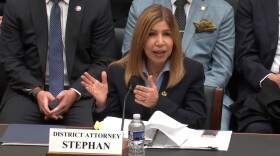More and more politicians are telling voters that migrants are invading the southern border.
That is what State Assembly candidate Carl DeMaio told his 50,000 followers on X earlier this year. He’s not the only local candidate sounding the alarm.
El Cajon Mayor Bill Wells has used the word invasion throughout his congressional campaign.
“What’s happening at our southern border is not just a crisis, it’s an invasion,” he said in a recent video.
They’re not alone. Politicians, particularly Republicans, are increasingly using invasion rhetoric to describe illegal immigration along the southern border.
Earlier this month, former President Donald Trump told supporters in New York that he believes — without evidence — that migrants are “building an army.”
“We are not going to let these people come in and take our city away from us and take our country away from us,” he told a cheering crowd.
Experts who track this rhetoric are worried.
“We’ve identified over 165 members of Congress in their official capacity that have engaged in invasion or other replacement theory-type rhetoric, and I think that is really concerning,” said Zachary Mueller, senior research director at America’s Voice, a pro-immigrant advocacy organization.
Mueller is concerned because invasion rhetoric comes from and promotes white nationalist ideology.
“The language of invasion is inexorably tied to this idea of the Great Replacement Theory, which has inspired multiple domestic terrorist attacks over the last couple of years,” he said.
Mueller described the Great Replacement Theory as a conspiracy claiming that political elites are bringing nonwhite immigrants into the country to replace the voting power of native-born white United States citizens.
In 2019, a gunman murdered 23 people in an El Paso, Texas Walmart 20 minutes after posting that the mass shooting was “in response to the Hispanic invasion of Texas” in an online message board.
In 2022, a white gunman killed 10 Black people in a supermarket in Buffalo, New York. Federal prosecutors pursued hate crime charges, citing the shooter’s writings that “his motivation for the attack was to prevent Black people from replacing white people and eliminating the white race, and to inspire others to commit similar racially-motivated attacks,” according to the complaint.
When high-profile politicians like Trump use invasion rhetoric, they introduce white supremacist ideology to a mainstream audience, Mueller said.
“When leaders of the party embrace this sort of rhetoric, it gives permission not only for other Republicans to start embracing that rhetoric but also their supporters and, unfortunately, it lowers the threshold for individuals to hear it,” he said.
The concern is that people who “have hate in their heart and a gun in their hand” act on that messaging, Mueller added.
Wells and DeMaio did not respond to questions about their use of invasion rhetoric, or interview requests to discuss the situation along the border.


A long history of invasion rhetoric in California
The use of the term “invasion” to describe immigrants has a long history in California, according to Natalia Molina, a professor at UC San Diego who studies the construct of race in the U.S.
In 1873, The San Francisco Chronicle published several advertisements for a book about “The Chinese Invasion” that asked readers, “What are you going to do about it?”
Political cartoons from the 1880s show California as a sinking ship falling under the weight of too many Chinese migrants.
That kind of rhetoric led to the passage of the Chinese Exclusion Act of 1882, which essentially banned immigration from China, Molina said.
“This was a time in which the Chinese had performed labor for us and once we had a recession and didn’t need that labor, rhetoric increasingly turned against them to the point where they actually banned Chinese immigration,” she said.
But it didn’t stop there. A headline from the Chicago Tribune in 1903 says “America Invaded by Alien Swarm.”
Over time, those negative views of Chinese laborers shifted toward Latino immigrants. Molina describes this as an example of “racial scripts,” the idea that racialized policies and stories about one group are applied to others.
Other examples include mass deportations of Mexican laborers during recession periods in the 1920s and 1940s, she added.
Molina used more recent examples of invasion rhetoric in some of her classes at UCSD, including a 1994 campaign ad from former San Diego Mayor and California Gov. Pete Wilson.
The ad plays ominous music and shows grainy black and white images of immigrants crossing the border while a deep, serious voice says, “They keep coming. Two million illegal immigrants in California. The federal government won’t stop them at the border.”
Apart from being dangerous to immigrant communities, Molina believes invasion rhetoric is also counterproductive to finding solutions to the broken immigration system.
San Diego was the busiest corridor for illegal crossings along the entire southern border in April — something that hasn’t happened since 1998, according to data from Customs and Border Protection. The federal government has struggled to process large numbers of migrants entering the country illegally. And several cities throughout the country have been overwhelmed by the arrival of new immigrants.
People have genuine questions and concerns about the current levels of immigration. But simplifying the issue does not answer those concerns, Molina said.
“How you define a problem defines the solution,” she said. “If you define it as an invasion, well then it’s a matter of putting up a wall.”
That kind of language distracts policy makers from engaging in a more serious debate, she added.
“How do we encourage legal immigration, is our system even set up for legal immigration, at what level do we want immigration?” she said. “Those are much more nuanced discussions.”
Federal judge rejects invasion claims
Apart from inspiring violence and stifling good-faith debate, invasion rhetoric is also factually inaccurate, according to Michelle Lapointe, legal director at the American Immigration Council.
The accuracy of the use of the word “invasion” recently came up in a federal lawsuit in Texas.
Gov. Greg Abbott argued that Texas was under invasion while trying to justify a law that granted deportation powers to state and local police officers and judges.
Judge David Ezra, who was appointed by former President Ronald Reagan, rejected that argument.
“He started by saying that to discuss this invasion claim at length is to take the argument more seriously than it deserves,” Lapointe said.
Then he spent more than 20 pages of his 114-page order dismantling the governor’s position.
“To start, surges in unauthorized immigration alone do not qualify as an ‘invasion’ as described in the constitution,” Ezra wrote.
Ezra acknowledged that Texas is under pressure to deal with the influx of migration, but said in court that he saw no evidence of any type of military invasion.
Lapointe said the case in Texas is a sign of a trend — invasion rhetoric making its way into state legislatures.
“It is unfortunately coming up in legislative debates in other parts of the country including states far from the U.S.-Mexico border,” Lapointe said.
Molina said state lawmakers are “invoking the same dangerous and violent rhetoric to justify anti-immigrant measures at the state level.”
More spending than ever
Political spending on anti-immigrant campaign ads is already increasing ahead of the November general election, according to data from America’s Voice.
In 2020, more than $50 million was spent on anti-immigrant campaign ads. That amount more than quadrupled to $233 million in 2022. And now, the 2024 election is already on pace to surpass that. So far this year, spending on those types of ads is already at $160 million.
“We are on pace to see the most money ever to be spent on anti-immigrant ads,” Mueller said.
Given the increase in spending, people should expect to see more invasion rhetoric leading up to the November election.
Molina advised people to avoid taking these types of political ads too seriously and to seek out independent, fact-based sources of information.
“We can’t rely on the ads because they are designed to be inflammatory,” she said. “They are designed to get your attention for 30 seconds.”
Part of the reason invasion rhetoric is so pervasive throughout our history is that it taps into people’s legitimate anxieties about their identity, safety and economic security, Mueller said.
But in a way that blames immigrants for those anxieties, he added.
“We can disagree on what immigration looks like, and I think in a democracy it’s important that we disagree,” he said. “But when we are using language like invasion, we cross a different threshold, which is that we are engaging in rhetoric that has inspired violence.”







